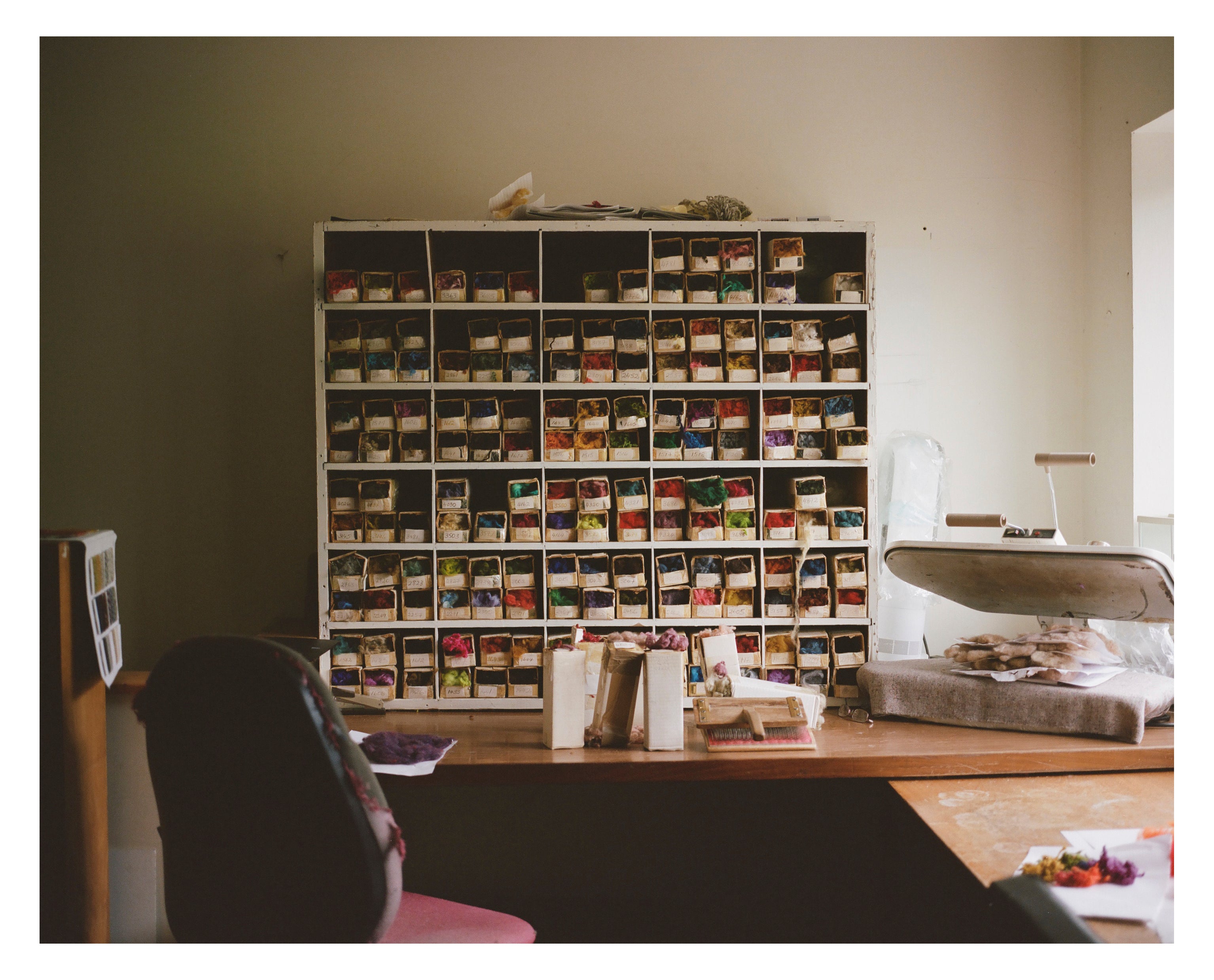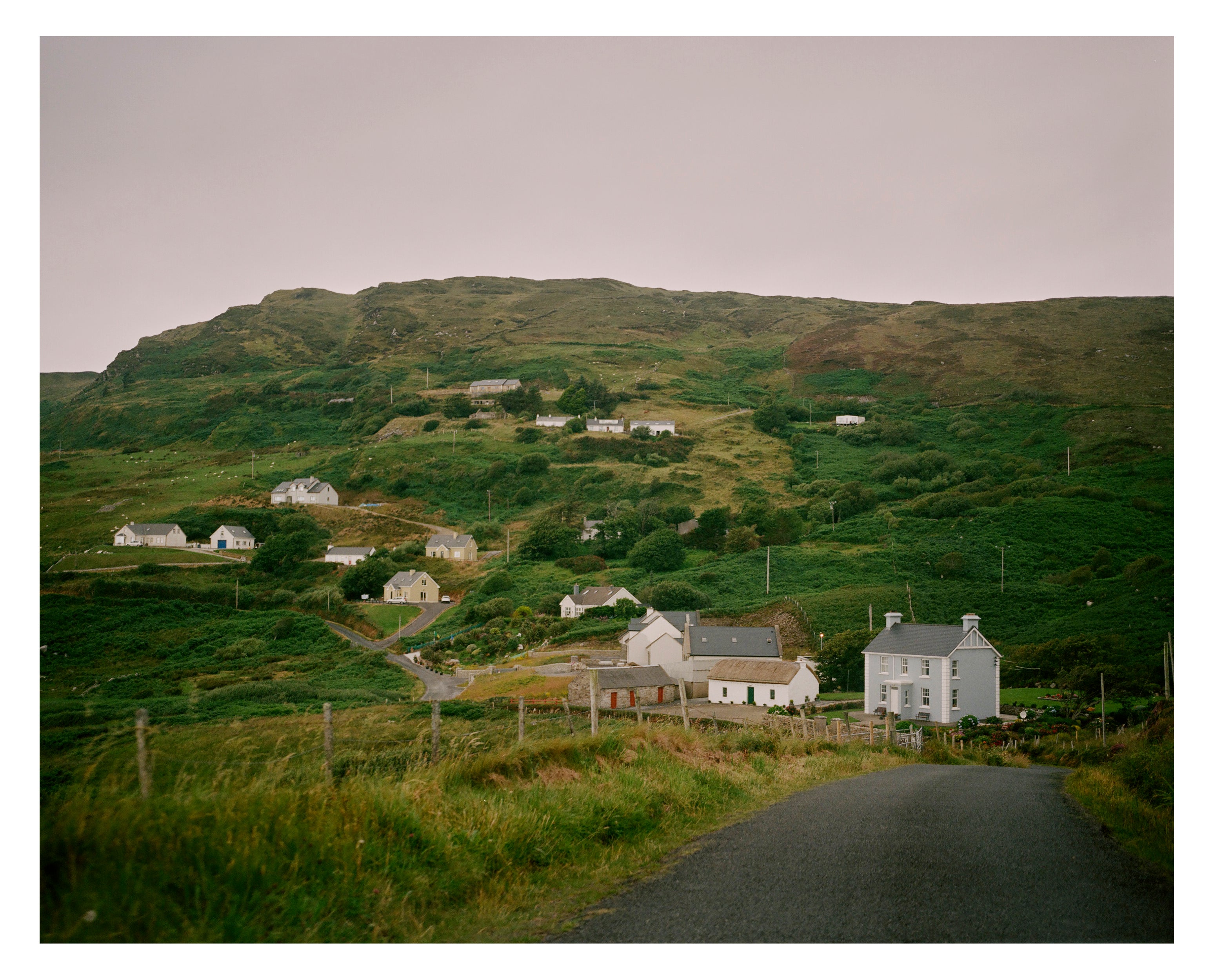
TOAST has been working with Donegal Yarns, in Northwest Ireland, for many years. This season they have created the yarn for our Easy Sweater in three shades - Cinnamon, Mist and Mimosa Yellow. We visited the team and found out about the processes involved.
The road to Donegal Yarns is a winding one. Curving along the coast, it runs past steep, cathedral-like cliffs that rush down into a blue-grey sea. Either side are wide stretches of grassland, broken by a patchwork of dry stonewalls and the houses lie low, as though hunkering down against the wind. Sheep and their thick white fleeces punctuate the verdant green firm reminders of the county's knitting heritage.


For centuries, the word Donegal has been synonymous with a flecky, colourful woollen yarn. Whereas this yarn was once hand dyed and spun in cottages across South West Donegal to be used for both knitwear and the weaving of Donegal tweed cloth it is now manufactured on a larger scale by Donegal Yarns, in the village of Kilcar.
As we turn into the village, nestled between two hills, the spinning mill comes into view. From the front it appears relatively small, but on entering it is cavernous, the entrance filled with bundles of wool, stacked high.
We are greeted warmly by several members of the team who usher us into a meeting room, offering welcome cups of tea. After introductions, Chris, the mill's General Manager, tells us how there has been a mill on this site since the early 1900s.
"It was originally state-sponsored," he explains, "set up to meet the growing demand for Donegal yarn. As the textile industry expanded, the mill was able to provide further employment to an area that had been historically dependant on agriculture and fishing." In 2006 the mill was taken over by private investors, becoming Donegal Yarns.


We begin our tour of the spinning mill upstairs. This is where it all starts, says Chris, gesturing around. In this room, Nora mixes the colours that TOAST knitwear designer Emma has specified.
The room is small and unremarkable but for its large and captivating centrepiece a display of brilliantly coloured wools, all spilling out of their boxes.
Nora is responsible for colour and she describes it as being like a painter. "I think of it as my colour palette," she explains, "picking out different wools, as soon as I see a particular shade, I'll know which colours I need to achieve it, and how much of each."
This is quite a skill. Purely by eye, Nora is able to work out the quantities to create an exact shade. In an easy, and much practised manner, Nora chooses her colours and begins to card the wool by hand, passing it back and forth between the teeth of the two carders. By doing this she is, she notes, repeatedly breaking down the fibres and realigning them, so that they all face in parallel lines.
Nora then takes the wool and quickly but carefully spins it by hand, passing the finishing yarn to us. It is a beautiful, warm colour with shades of ochre, sand and rust. "That's the yarn for your sweater," smiles Nora, "it's a lovely colour."


"What you've just watched Nora do is basically a very simplified version of what's going on out there," says Chris, "pointing to the mill floor." Leading us back downstairs he shows us the wool in its initial, un-spun state. He encourages us to sink our hands into one of the open sacks it's like cloud, dense, soft and so many shades of white. "I still enjoy that feeling," he says, laughing.
As he speaks, a gust of steam erupts from a vat behind him. "Those are the dye vats," Chris explains. "First we wet the wool, to make sure it takes the dye evenly, then it goes to Joseph for the dyeing." Joseph is the dye house manager and has followed in the footsteps of his father, who worked in the dyeing department in the 1950s. Each dye is carefully mixed using exact ingredients.


Once dyed, the water is pressed out of the yarns and they are put in an oven-like contraption for drying. They are then sent for blending, a process that creates the iconic, flecky appearance and the rich depth of colour.
"Look at this," says Chris, opening the door to the blending room. It is a truly wonderful sight. Inside this tall room are thousands of brightly coloured, variously sized, woollen fibres, looping, spinning and summersaulting around one another, carried by gusts of air.


The blended fibres, which have had oil added to them to reduce static, are then heaped together, put into bales and sent to the carding room. Here Nora's hand process is blown up on an extraordinary scale.
The bales are attached to a hopper at the back of the carding machine and these rollers, called workers', spin continuously, breaking down and intermixing the fibres. The carding machine itself is enormous, comprising of hundreds of complex cogs. It is a feat of engineering, allowing for a once laborious, manual process to be cleverly mechanised.
Running off the carding machine is a long, translucent web of speckled, multi-coloured fibres. This fleece-like ribbon known as a 'sliver' is gently wound onto bobbins, reading for spinning. "It is still incredibly weak at this point, but the spinning adds a twist, giving it strength," explains Chris.


The mechanisms that spin the wool are hypnotic to watch and the yarn being spun in front of us is gossamer-like. Depending on the quality of the yarn, there are different settings on the spinning machines. For example, the heavier spun yarns, such as our 'Donegal special yarn' would have between 4-5 TPI's (Turns Per Inch). This creates the homespun effect, allowing the natural fibres to interlock.
Lastly, the spun yarn is either washed, turned into hanks, or wound onto cones, in order to meet the customer's needs. "It's a mixture of new technology and old traditions," says Chris. "But because of all this," he gestures to the machinery surrounding us, "we can produce the Donegal yarn in much greater quantities and send it all over the world."


There is so much pride in the traditional Donegal yarn; it's evident in all our conversations with the dyers and spinners here, many of whom have been with the mill for over thirty years and are second or third generation.
Seamus, who has his own large flock of sheep, has been working with wool all his life and began his career with mill in 1973. "We can't get rid of him!" laughs Chris.
The humour is good-natured, Seamus is clearly prized within the company and is currently passing on his knowledge to the next cohort. "The Donegal yarn is part of this community," says Chris, "it's in so many families, in so much of the cloth, it's even in the landscape."


On the journey back, Chris's words come to life. We see the colours of the flecks in all that we pass the rusty lichen on rocks, the deep blue of mountain tops, the blue-blacks of moorland, the rich browns of peat, the soft purple of wild flowers and the changing colours of the vast sky, as it stretches to the horizon.
Words by Emily Mears. Photography by Kendal Noctor.
Shop our Orla Donegal Wool Sweater and Donegal Wool V-Neck Cardigan.

Add a comment
2 comments